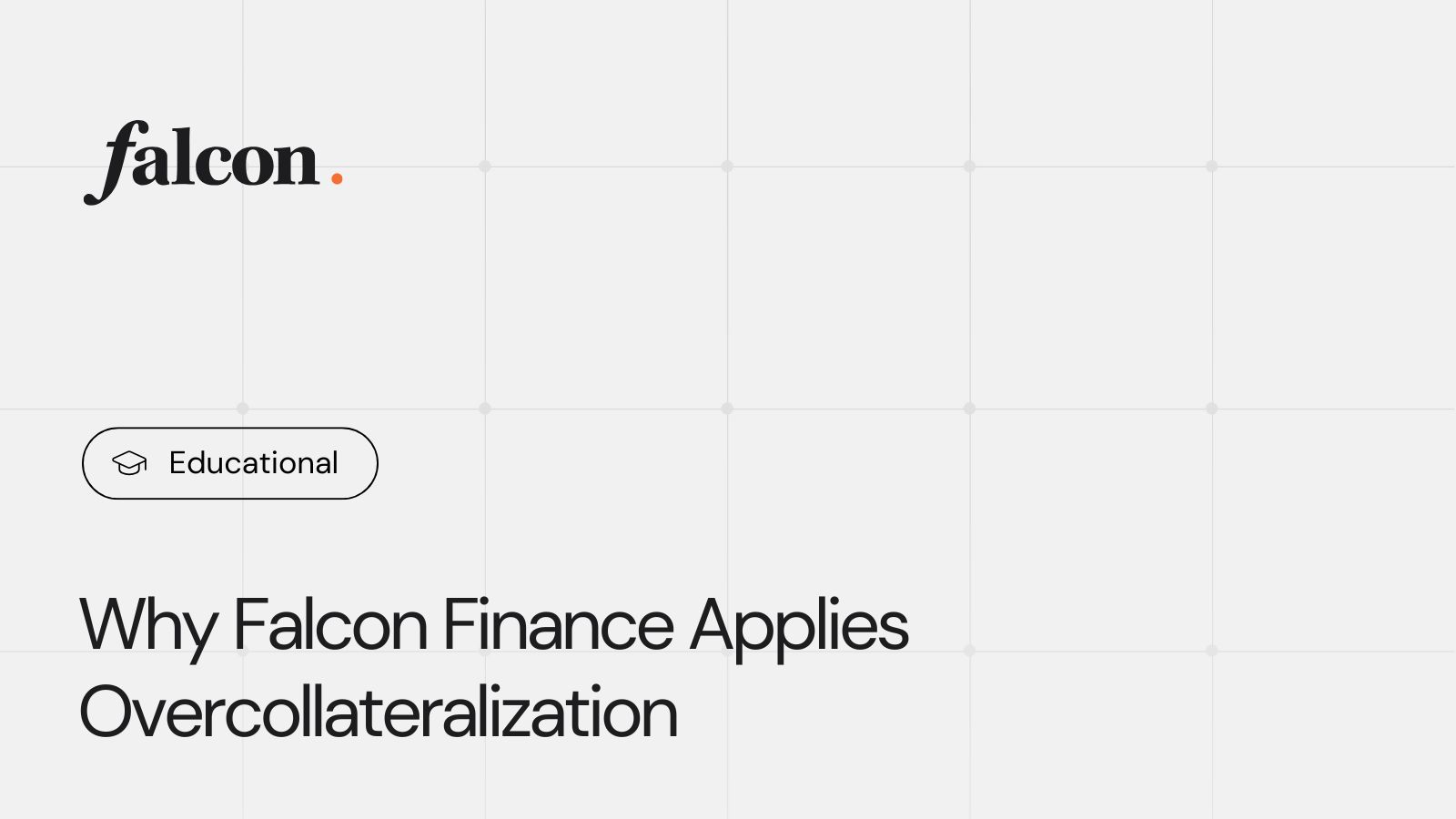Why Does Falcon Finance Apply Overcollateralization to Altcoin Collateral?
Updated • 4 Sept 2025
Published • 5 Jul 2025
4 mins

The diverse range of digital assets accepted as collateral is one of the key features of Falcon Finance. However, as cryptocurrencies are prone to price volatility, sharp market fluctuations could lead to a decrease in reserves’ value. To mitigate this and some other risks, Falcon applies overcollateralization to all deposits that are not stablecoins. This article explores the reasoning behind this approach, how it works, and its importance for the protocol’s resilience.
What Is Overcollateralization?
Overcollateralization is a risk management mechanism that requires users to deposit more collateral than the amount of USDf tokens they receive. At Falcon Finance, this applies specifically to non-stablecoin assets like Bitcoin (BTC), Ethereum (ETH), Solana (SOL), and other supported altcoins.
For example, if BTC has a 20% overcollateralization requirement, a user must deposit $1,200 worth of BTC to mint $1,000 worth of USDf. This extra 20% acts as a buffer to absorb price volatility, helping ensure USDf remains fully backed even if BTC’s value declines.
Overcollateralization rates are not fixed but dynamically adjusted per asset based on factors such as historical volatility, liquidity, and slippage risk.
In contrast, stablecoins like USDC and USDT are treated as low-risk assets and can be used to mint USDf at a 1:1 ratio, with no overcollateralization required.
Why Is Overcollateralization Necessary?
There are several reasons Falcon utilizes overcollateralization.
1. Volatility Risk
Altcoins, unlike fiat-backed stablecoins also accepted by Falcon, are subjected to significant and unpredictable price swings. Even “blue-chip” cryptocurrencies like Ethereum (ETH) and Bitcoin (BTC) have experienced double-digit percent changes within hours. Less liquid or newer altcoins are even more volatile. If a protocol were to allow 1:1 minting of USDf against these assets, a sudden drop in collateral value could leave USDf undercollateralized, threatening the protocol’s stability and the ability to redeem USDf back to other cryptocurrencies 1:1.
2. Holders’ Protection and Protocol Stability
Overcollateralization serves as a safety net, ensuring that even if the price of an underlying crypto asset falls sharply, the minted USDf remains fully backed by sufficient value. This is essential for maintaining user confidence in the Falcon Finance protocol and for the functioning of the broader ecosystem, as USDf must be redeemable at face value regardless of market turbulence.
3. Market Slippage and Liquidity Constraints
Many altcoins face lower trading volumes and thinner order books compared to stablecoins or major cryptocurrencies. If large positions must be liquidated (e.g., in a rapid market correction), prices can fall sharply due to slippage. By requiring excess collateral, Falcon Finance prevents the inability to fully cover outstanding USDf due to a rapid liquidation.
4. Dynamic and Risk-Adjusted Approach
Falcon Finance does not use a fixed overcollateralization ratio for all altcoins. Instead, ratios are dynamically set based on each asset’s volatility, liquidity, market slippage, and historical price behavior. This enables a more capital-efficient system for less risky assets, while protecting the protocol from outlier events and flash crashes for higher-risk altcoins.
User Benefits
Apart from the general protocol stability and higher resilience to external shocks, it provides multiple benefits to Falcon Finance users, as well:
- Protection against depegging: Ensures USDf is always backed, even during severe altcoin market downturns.
- Builds confidence: Institutional and retail users can trust USDf’s stability.
- Enables broader collateral inclusion: Falcon users can put more of their crypto portfolio to work without jeopardizing protocol solvency.
- Enhances sustainability: Supports consistent yield generation without sacrificing security or stability.
Overcollaterization for Collateral Redemption
Upon redeeming their crypto principal back, users reclaim their original collateral if the price has stayed the same or fallen. If the price has increased, they receive back an amount of altcoin equivalent to their original USDf value, ensuring the protocol does not suffer losses due to collateral appreciation.
The Overcollaterization Principle in Crypto and DeFi
Overcollateralization is not unique to Falcon Finance. Instead, it is a well-established risk management principle, which was used in the leading blockchain protocols like MakerDAO (DAI) before it got relaunched as Sky Money, Liquity (LUSD), and many others.
However, Falcon applies the principle more flexibly by dynamically calibrating its ratios, supporting a wide array of collateral types, and offering real-time transparency on reserve status and risk profiles.
Conclusion
Overcollateralization is foundational for Falcon Finance’s design, safeguarding against market volatility while accepting altcoins as collateral. By maintaining dynamic, risk-based buffers, Falcon offers a stable synthetic dollar, USDf, enabling users to access yield opportunities using a diverse array of digital assets. This blend of capital efficiency and caution is key to Falcon Finance’s status as a next-generation synthetic dollar protocol.
Tags